Jon Cooper’s Adam Park Story
2Introduction
In 2009, the Coopers arrived in Singapore from the UK. Jon’s wife had a job posting here and Jon was to be during the duration of her posting, a house husband taking care of their 2 young children and running the household. As luck would have it, on the morning after they moved into their home, Jon on a “reconnaissance” of his new neighbourhood spotted a National Heritage Board marker introducing the WWII history of Adam Park.
From that day onwards, Jon’s life took on a different direction. Trained as a battlefield archeologist, he was to spend the next 9 years, juggling his responsibilities as husband and father with his passion for battlefield history, Singapore after all is rich and fertile ground for the “digging up” of WW II history.
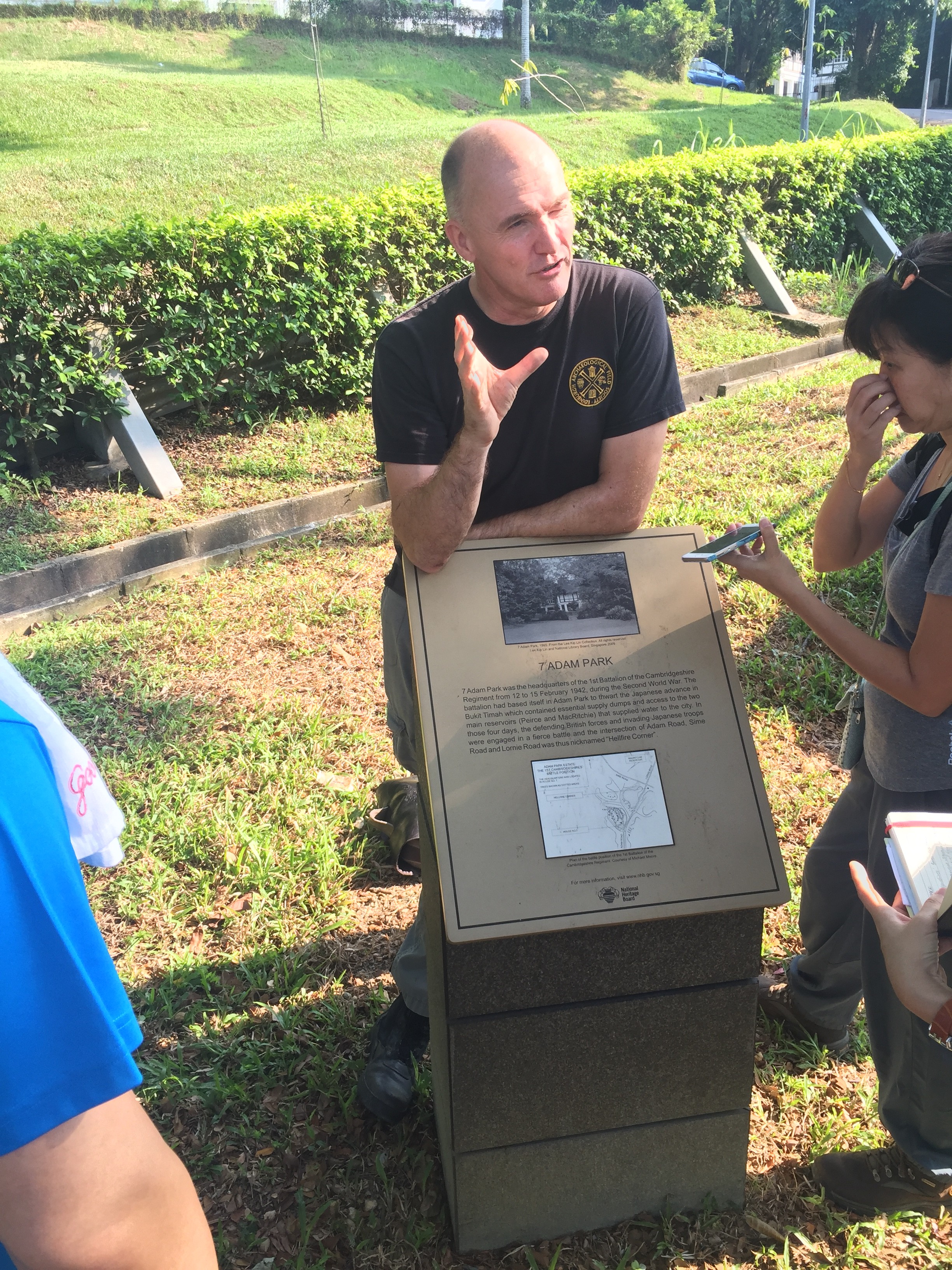
Jon Cooper and the NHB marker about Adam Park. The marker had been refurbished and revised by NHB recently (photo by Simone Lee)
Jon and his family moved back home to Scotland in July this year. In the time Jon was here, his contributions to WW II history included the regular once a month “Battle at Cemetery Hill” guided walks for All Things Bukit Brown which started in June 2012, an exhibition co-curated by Jon under Singapore Heritage Society held at National Library in commemoration of the 70th Anniversary in 2012 of the Fall of Singapore –Four Days in February: Adam Park the Last Battle- over 20 archeological digs as part of The Adam Park Project (TAPP) capping it all by the publication of Tigers in the Park. Published just weeks before he left for home, Simone Lee attended the last of the Tigers in the Park tours held in conjunction with the book’s launch.
=========
Jon Coopers Adam Park Project by Simone Lee
Adam Park is a significant place in Singapore’s history because it was where one of the last and fiercest battles was fought and was subsequently a prisoner of war (POW) work camp.
Located at the crossroads between Bukit Timah and MacRitchie Reservoir, Bukit Timah is the highest point in Singapore and where the British army supplies were kept. The Japanese captured Bukit Timah on 12th February 1942 and set its sights on cutting off the water supply to the city. The British troops guarding the Water Tower along MacRitchie Reservoir were ordered to move the defence line outward towards Bukit Timah, and engaged in battle with the Japanese troops at the halfway point which was Adam Park.
At Adam Park, Jon sets up the battlefield of engagement and from his research which includes oral interviews with war veterans, former residents of Adam Park, descendants and pouring over diaries and other private papers, Jon brings to life compelling stories of the people at Adam Park, igniting an important component of WW II , its social history.
The colonial black-and-white bungalows at Adam Park were built in 1929 for the European community. Generous lawns allowed for tennis courts and putting greens. The driveways had space for cars owned by residents and their guests. It is a beautiful, genteel estate away from the city and conveniently located close to the golf course which now belongs to the Singapore Island Country. Here are some highlights of the various houses with significant stories to tell in the book.
House No.16
Located on top of the hill, and dubbed ‘Bachelor’s Mess’ during the war, the first family to occupy house was the Dutch Consular General, Mr.Hendrik Fein, his wife and their “celebrity” daughter, Concha. They lived there for a few months in 1938 before moving to Mount Alma. Concha was reputed to be a great beauty, young and vivacious who became popular for helping the Singapore Charity Cabaret and regularly entertained the Allied troops. Unfortunately, Concha and her family were in the plane which went missing on its way to Australia when they were evacuated at the onset of war. Their plane was one of 2 carrying passengers from Java. The other plane landed safely in Melbourne with one of its passengers being Lieutenant General Gordon Bennett, who relinquished his post as the Commander of the Australian Army’s 8th Division in Singapore to escape being captured by the Japanese when it fell.
The Seefelds moved into No.16 after the Feins’. They had escaped Hitler’s persecution of Jews in Germany to England and then joined their sons in Singapore in 1939. Seefeld Snr continued his practice as a dentist here, but when WW II arrived on our shores, his family were rounded up along with other Germans and deported. Leaving in haste, the family left all their belongings, including a complete set of what was considered high-end dental equipment then and, furniture that he had brought with him from Germany. The dental set was later used by the Japanese military during their occupation. To the Seefeld familys’ astonishment, the entire set was then shipped to them in Australia, intact, shortly after the war ended.
While the city was being bombarded with daily air raids which began in December 1941, the Adam Park estate was barely touched by the bombings. No.16 became home to the Morrisons after the Seefelds and a few other families had also taken refuge in the house after homes in the city were destroyed. It was a short lived refuge. On 31st January 1942, the Morrisons left their home to board a ship out of Singapore. Their ship, the Empress of Japan had docked 2 days earlier carrying British soldiers from the 18th Division. The Empress left Singapore with civilians escaping the war, and by the time it arrived at Liverpool, it had a new name, the Empress of Scotland.
As the city was besieged, allied troops retreated to Adam Park. House No.16 saw action in the battle between the 1st Battalion Cambridgeshires and the 41st Regiments of the Imperial Japanese Army at Adam Park on 13 February 1942, 2 days before the British was to surrender Singapore.
House No.12
Despite being one of the last residents to evacuate the estate, Philip Cooper Sands returned to his home at No.12 each day during the battle at Adam Park and gave vivid accounts of the bombardments surrounding the house in his diary, and letters to his wife who had left on the same ship the Morrisons were on.
Read more about their stories in ‘The Residents of Adam Park’ page 33 of ‘Tigers in the Park’.
House No.20
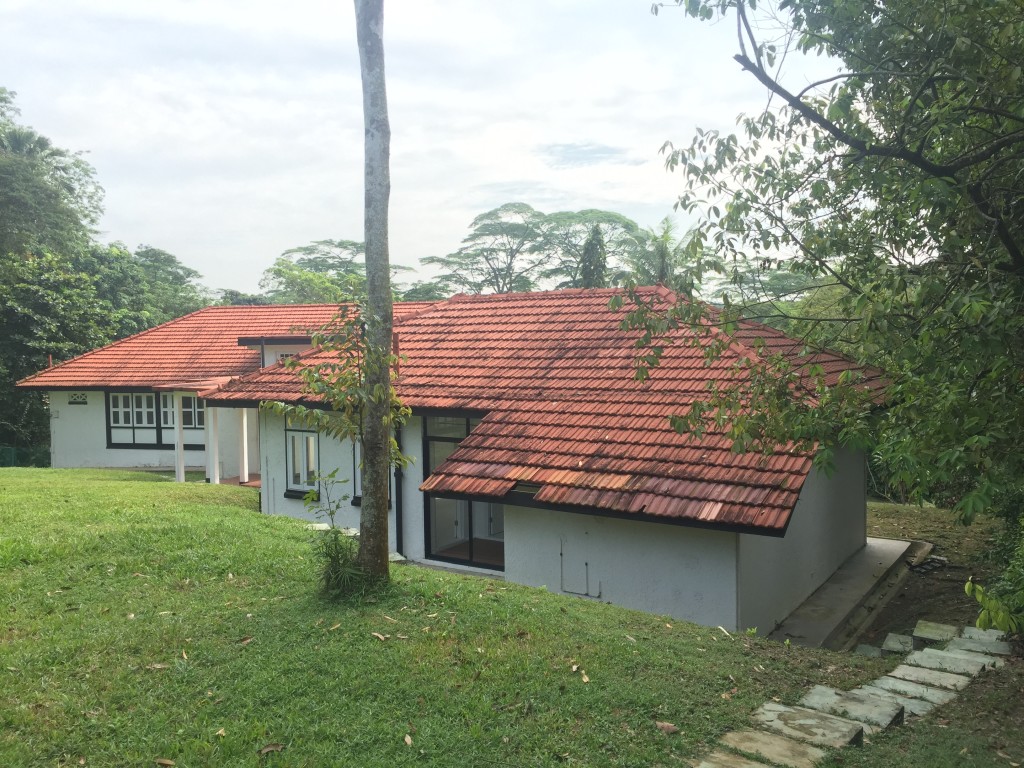
With some imagination, we could assume that the patches on the walls of house no.20 may have been battle scars from the mortars fired to drive the Japanese soldiers out of the house (photo by Simone Lee)
A few metres down the hill from house No.16, a triple coil Dannert barbed wire fence had been erected in front of house No.20. While about 100 men from the 1st Battalion’s D Company held on at houses No.13 and 14, C Company joined them late in the night on 13th February and set their positions at the remaining houses surrounding the defense line. To their dismay, they woke the next morning to find some 23 Japanese soldiers in house No.20. Apart from being exhausted from combat at MacRitchie the day before, the men at C Company were not aware that D Company had shifted their positions and unknowingly left house No.20 empty. A battle ensued between the new “neighbours”
Read more about the battle at house No.20, and how Corporal Pearson and Lieutenant Clift earned their medals from this battle in ‘Adam Park: HQ, C and D Companies, 1st Battalion Cambridgeshires Regiment’ and ‘The West End of Adam Park Estate: C and D Company, 1st Battalion Cambridgeshires Regiment’ from page 140 of ‘Tigers in the Park’.
House No.17 – Regimental Aid Post (RAP)
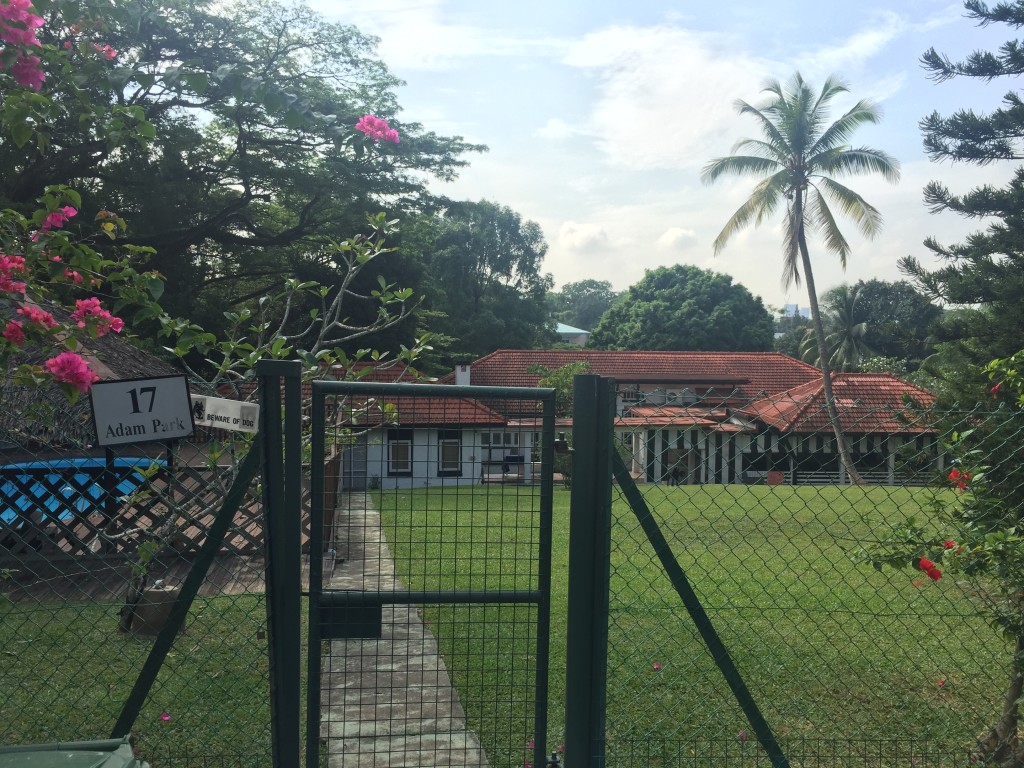
The Regimental Aid Post, House No.17. Injured soldiers sprawled onto the lawn after evacuating the house when it caught fire (photo by Simone Lee)
Red Cross banners hung from the windows of house No.17 which became the Regimental Aid Post (RAP) for the 1st Battalion. It was the first medic point for injured soldiers before being transferred to a hospital in the city. By 15th February, the RAP was overwhelmed with Cambridgeshire casualties. The medics were working quickly to attend to every injured soldier brought in while some of those wounded but could still walk, helped out. Six medical ambulances had arrived that morning bringing some relief. But before they could be loaded and sent back to hospitals in the city, the vehicles were blown up, and the RAP was ruined. A British soldier had fired at a Japanese tank that was collecting their own wounded and in retaliation, the Japanese shot back. Rounds of bullets from their machine guns and tanks pierced through the walls of the house and the fuel tanks of the ambulances, setting them on fire. Everyone in the house scrambled out to the garden. Unbeknown to both sides, a ceasefire had already been called and received at No.7 to prepare for surrender.
Read Sergeant Len Baynes and Lance Corporal Cosford’s account of the attack on the RAP in ‘The Final Act’, page 191 of ‘Tigers in the Park’.
House No.7
House No.7 sits at the bottom of the hill on the eastern end of Adam Park along Adam Road. It was thought since it was located on the reverse slope, away from sight of the Japanese troops at Bukit Timah hill, No. 7 was most strategic to house the battalion’s headquarters. The battalion held up at the estate for 3 days of battle. However, by the end of the fighting, the Japanese troops had managed to infiltrate the surrounding areas. The house was then in full view of the enemies and bombarded by Japanese artillery.
On the afternoon of 15th February, Lieutenant Colonel Carpenter who was in charge of the 1st Battalion sent a message to the 54th Infantry Brigade headquarters to explain about their dire situation and asked permission to move the battalion away from Adam Park. Minutes later, the message of the surrender arrived. It took Carpenter a few moments for the message to sink in before sending out the order to cease fire. It took more than an hour for the message to reach the units at the other end of the estate.
While the Cambridgeshires were stricken with the shame of defeat, General Arthur Percival was negotiating the terms of surrender with Lieutenant General Tomoyuki Yamashita at the Old Ford Factory.
Read ‘The Final Act’ from page 191 of ‘Tigers in the Park’.
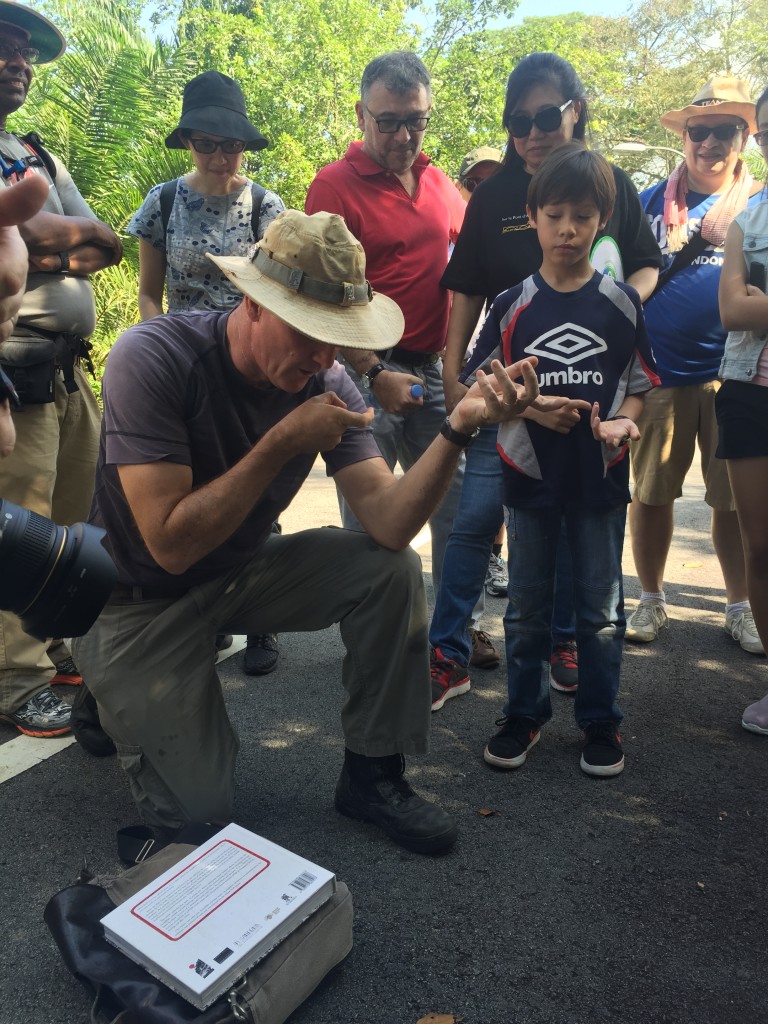
Jon reenacting a scene from the battle (photo by Simone)
The Aftermath
The day after the surrender, the surviving Cambridgeshires were packed onto a tennis court at one of the houses. They dug a single latrine at the corner of the court. The stench from it, drove the Japanese soldiers farther away as days went by and the latrine trench overflowed when it rained. On 19th February, a week after the Cambridgeshires had arrived in Singapore, they marched to Changi Prison to join the rest of the POWs.
A month later, the fittest POWs were moved to Adam Park. It became a working camp for some 2000 Australian and 1000 British POWs from March 1942 to January 1943. They were chosen to help build a Shinto shrine at MacRitchie Reservoir. But the first thing they had to do was to repair the war torn estate and settle in. They organized the estate into barracks and life at the Adam Park camp was comfortable compared to Changi Prison camp. They got the electricity, even air conditioning and water heaters working and enjoyed proper sanitary and ventilation. They picked up some Japanese language from chatting with the guards. Work was not considered too hard and hours were not too long. It was no holiday camp but they were provided with ample rice to cook and bought bread rolls and sweets from the canteen at house No.11 with the little money they were paid from the ‘Shrine Job’. And because the camp was not fenced up, some of the men would sneak out after the lights are out at 10pm to trade in the city for other sources of food.
Read ‘Settling In’, the ‘Shrine Job’ and ‘Trade’ from page 230 onwards of ‘Tigers in the Park’.
House No.11 – The Prison Chapel
One of the major facilities set up by the POWs was the “mess hall” which also housed a chapel. It was the second POW chapel remaining in Singapore, the first being the St Luke’s Chapel in Roberts Barracks which has been reproduced at Changi Museum. Captain Eric Andrews took on the role of a ‘padre’ to the men who sought spiritual guidance.
The house was badly damaged in battle. The chapel was on the second floor of the house, above the canteen. Because of the damage, the only access up the chapel was via the fire escape staircase at the back of house. Captain Andrews and a few volunteers repaired the remaining part of the room for the chapel and worked on designing the altar. It was plain and simple and they scavenged for materials they could find around the area – pieces of glass and transparent paper for the stained glass windows above the altar, yellow clay and Reckitt’s Blue for paintings on the wall.
The altar cross was bought from the Mortuary Chapel at Alexandra Hospital. Mother Mary and a scroll with the Bible verse; “Lift up your heads, O ye Gates and the King of Glory shall Come in” were painted. However, Captain Andrews was not able to draw faces very well hence he cut the face of Dorothy Lamour from a magazine and fitted it over Mother Mary’s. According to an account by Lieutenant Colonel Oakes, “Backlit from the outside the final image looked very impressive”.
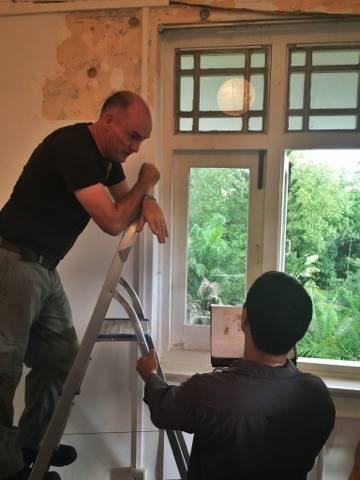
Jon Cooper explaining about the murals to Senior Minister of State, National Development Desmond Lee on a private visit. A small patch of the mural is visible above Jon’s head (photo Chua Ai Lin)
Jon’s research into the whereabouts of the chapel murals even when he had evidence of drawings from Mitchell, drew a blank when he interviewed survivors. He finally confirmed the location, when he realised, the men were more familiar with No.11 as the mess hall and canteen rather than the chapel. He was asking the wrong question!
Read more ‘The Prison Chapel’ from page 290 of ‘Tigers in the Park’
Today
All 19 houses at Adam Park which belong to the government are intact after repairs and available for rent. Most of the houses have been fenced and gated for security and privacy. House No.7 previously tenanted by National University of Singapore Society (NUSS) Guild House is at present unoccupied. No.7 and No.11 together with a handful of others are awaiting for new tenants. Without live in tenants, the buildings tend to wear out faster. But it is prime rentals and the market is weak.
Jon Cooper hopes that the estate will be preserved and protected by authorities. He believes that it is a heritage site that still has much to offer in research, and a tangible reminder of the stories that he and his team has uncovered. And because of its historical significance, the site can still be kept as residences by promoting low impact heritage, such as the small groups he has been conducting walks for, which don’t encroach on the privacy of residents and respect boundaries.

Jon Cooper’s tour becomes interactive when participants help reenact scenes from the battle (photo by Simone Lee)
Archaeology

Jon showing participants a Cambridgeshire cap badge, one of the many items found during the archaeology projects (photo by Simone Lee)
Jon Cooper started The Adam Park Project (TAPP), organising residents and recruiting volunteers to do archaeological work at the estate. Over 7 years, more than 1200 World War 2 artefacts have been dug up following 21 metal detector surveys and two excavations. The artefacts are now with the Iseas-Yusof Ishak Institute and Singapore History Consultants.
The artefacts and the stories behind some of the items, such as artillery shells, military badges, gas masks, and 19th century coins, have also been catalogued in TAPP’s Virtual Museum: http://www.adamparkproject.com/virtual-museum/
Tigers in The Park
Jon’s book is divided into four section, -section 1 covers civilian life in the estate before the war, 2, the battle at Adam Park, 3 POW life, and finally Adam Park, post war – comes with icons and QR codes leading to the Virtual Museum , a website which also allows visitors to comment and interact hence, allowing updates and amendments to the book to be made at real time.
Tigers in the Park can be purchased at larger bookstores and also online:
https://www.ethosbooks.com.sg/products/tigers-in-the-park



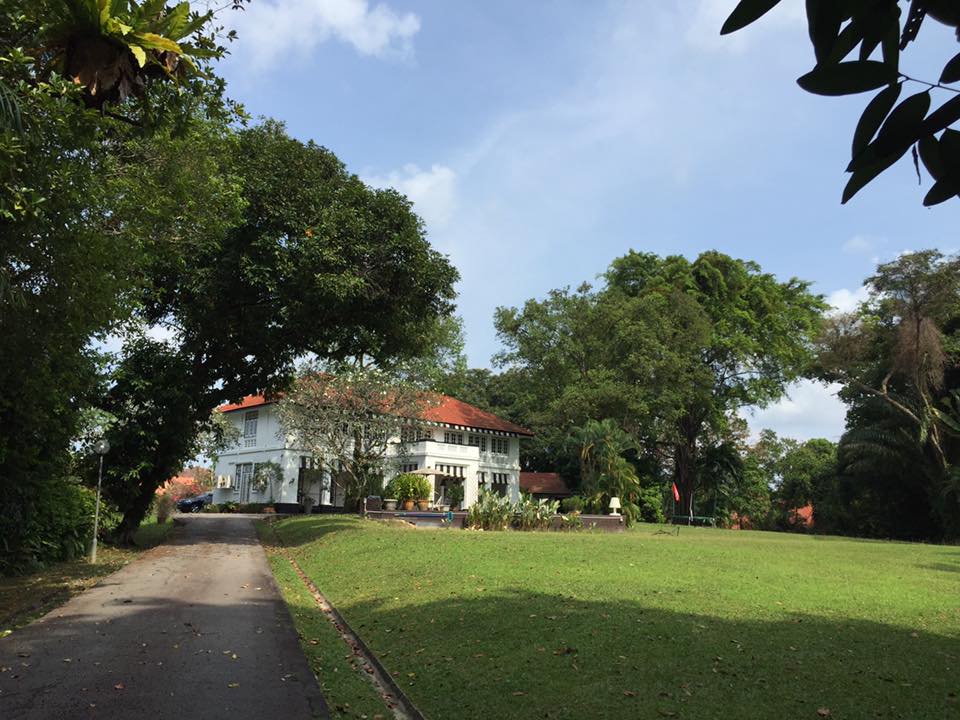
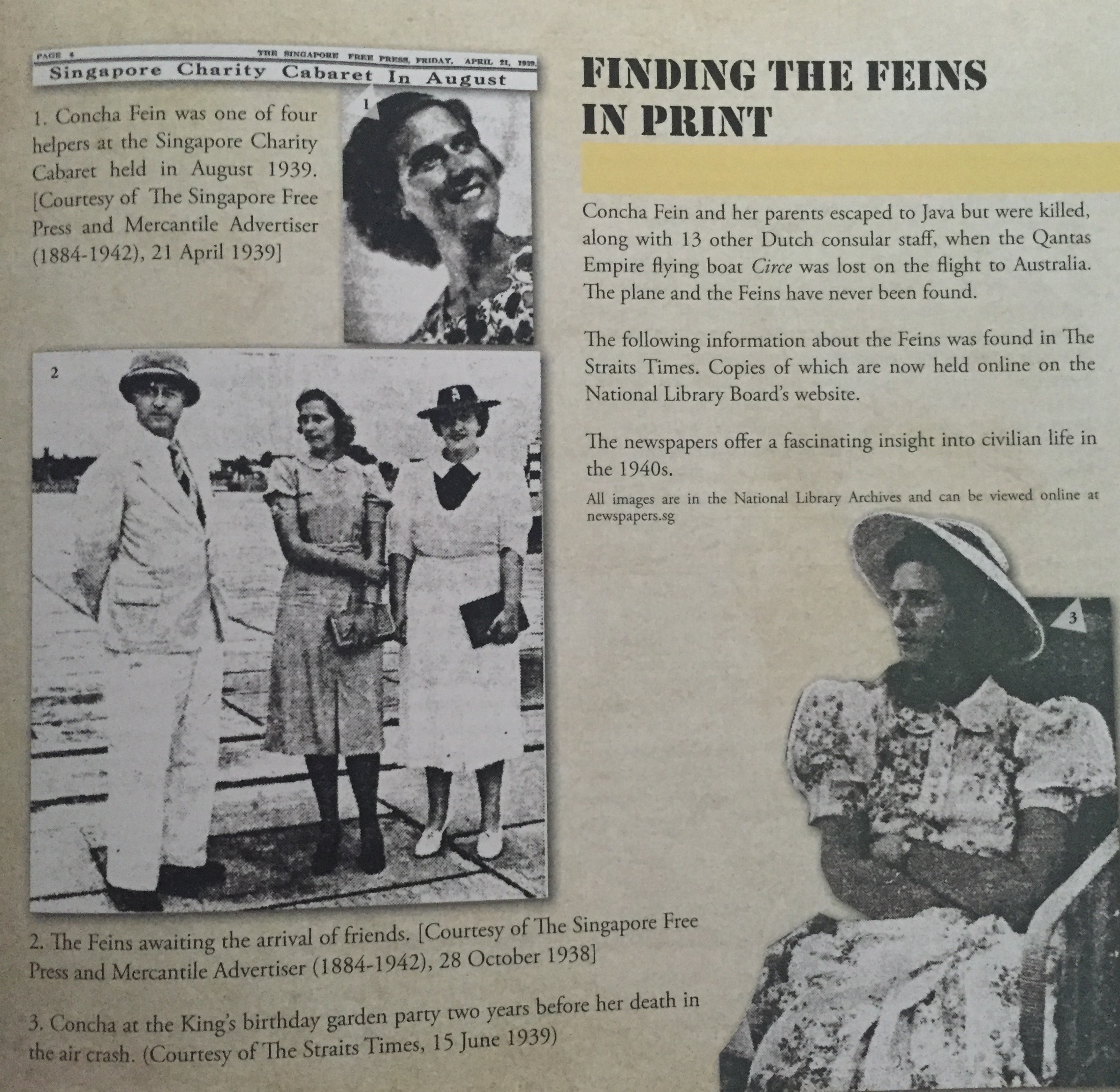
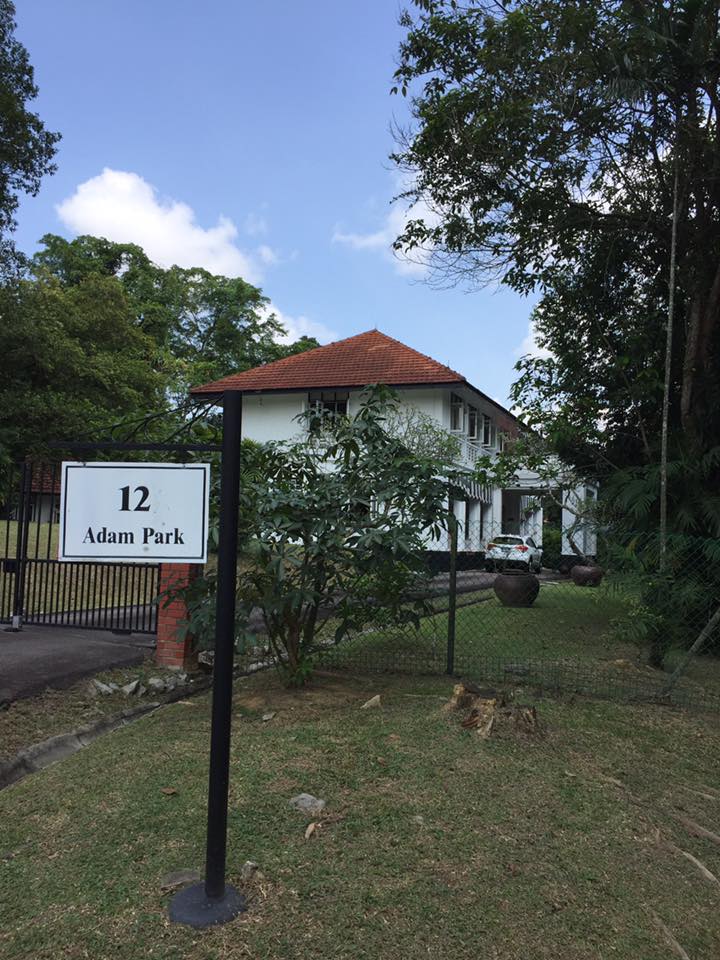



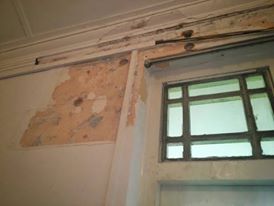
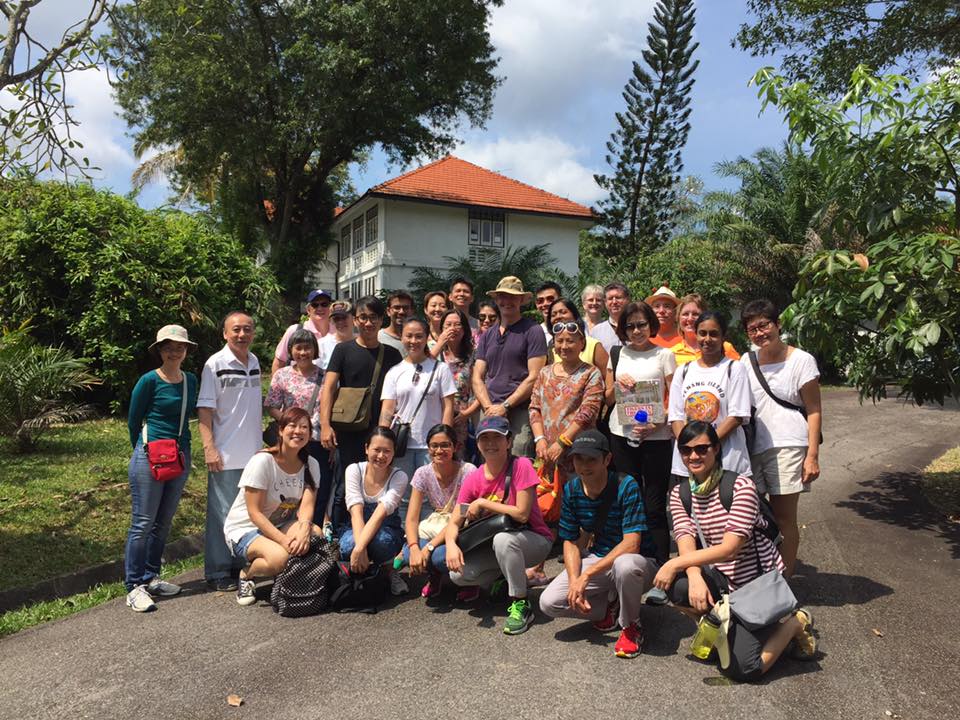


keep me updated when there are new posts. appreciate what you guys are doing for singaporeans and Singapore history. so much history has been buried under/eroded by what we call progress and development but I guess this can’t be helped as Singapore is such a small country we need all the progress and development we can manage. so putting it all down and sharing is better than nothing I guess 🙂